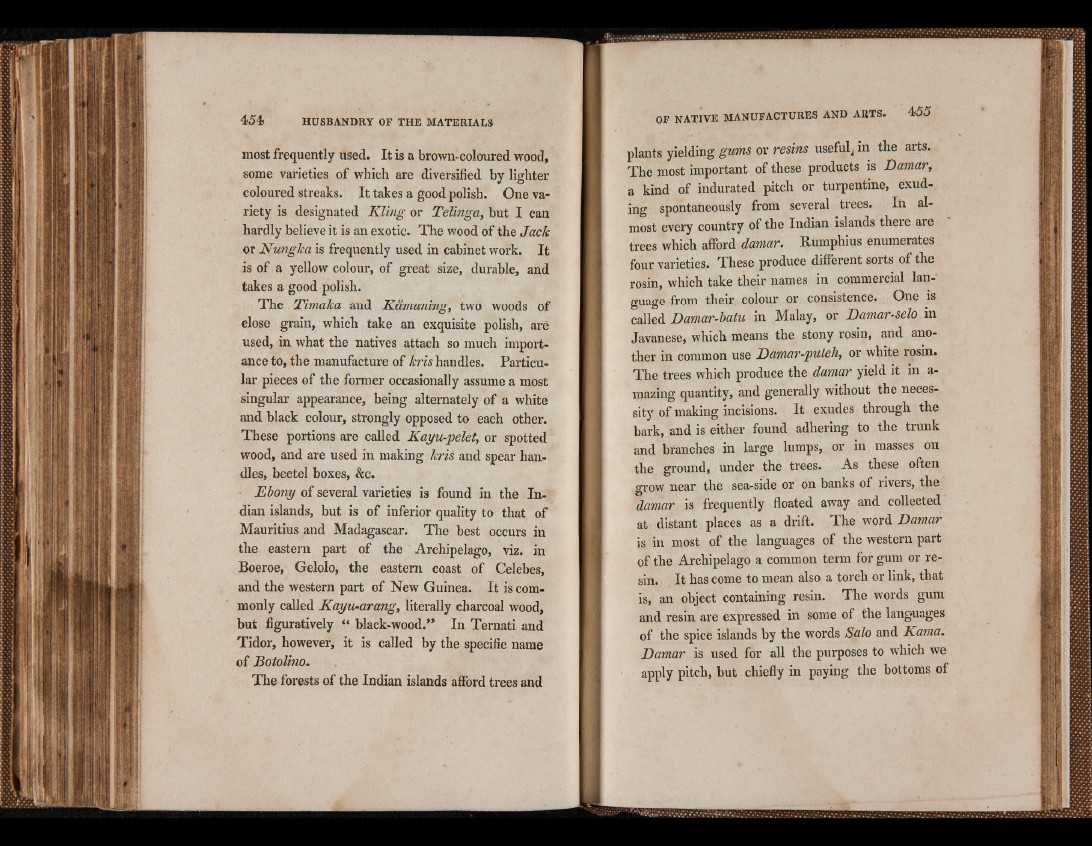
most frequently used. It is a brown-coloured wood,
some varieties of which are diversified by lighter
coloured streaks. It takes a good polish. One variety
is designated Kling or Telinga, but I can
hardly believe it is an exotic. The wood of the Jack
or Nungka is frequently used in cabinet work. It
is of a yellow colour, of great size, durable, and
takes a good polish.
The Timalca and Kamuning, two woods of
close grain, which take an exquisite polish, are
used, in what the natives attach so much importance
to, the manufacture of kris handles. Particular
pieces of the former occasionally assume a most
singular appearance, being alternately of a white
and black colour, strongly opposed to each other.
These portions are called Kayu-pelet, or spotted
wood, and are used in making kris and spear handles,
bee tel boxes, &c.
Ebony of several varieties is found in the Indian
islands, but is of inferior quality to that of
Mauritius and Madagascar. The best occurs in
the eastern part of the Archipelago, viz. in
Boeroe, Gelolo, the eastern coast of Celebes,
and the western part of New Guinea. It is commonly
called Kayu-arang, literally charcoal wood,
but figuratively “ black-wood.” In Ternati and
Tidor, however, it is called by the specific name
of Botolino.
The forests of the Indian islands afford trees and
plants yielding gums or resins useful, in the arts.
The most important of these products is Damar,
a kind of indurated pitch or turpentine, exuding
spontaneously from several trees. In almost
every country of the Indian islands there are
trees which afford damar. Rumphius enumerates
four varieties. These produce different sorts of the
rosin, which take their names in commercial language
from their colour or consistence. One is
called Damar-batu in Malay, or Damar-selo in
Javanese, which means the stony rosin, and another
in common use Damar-puteh, or white rosin.
The trees which produce the damar yield it in a-
mazing quantity, and generally without the necessity
of making incisions. It exudes through the
bark, and is either found adhering to the trunk
and branches in large lumps, or in masses on
the ground, under the trees. As these often
grow near the sea-side or on banks of rivers, the
damar is frequently floated away and collected
at distant places as a drift. The word Damar
is in most of the languages of the western part
of the Archipelago a common term for gum or resin.
It has come to mean also a torch or link, that
is, an object containing resin. The words gum
and resin are expressed in some of the languages
of the spice islands by the words Salo and Kama.
Damar is used for all the purposes to which we
apply pitch, but chiefly in paying the bottoms of